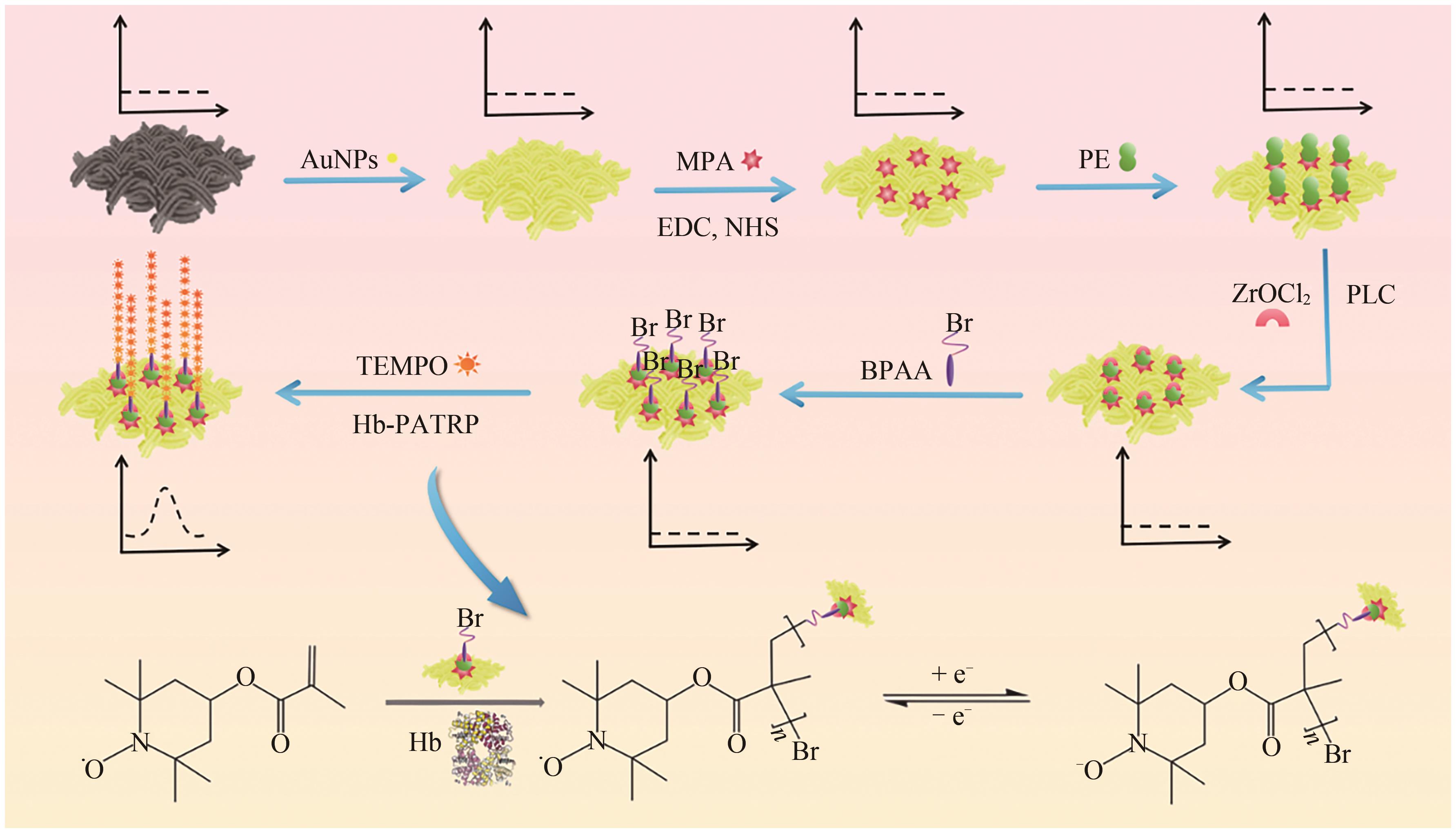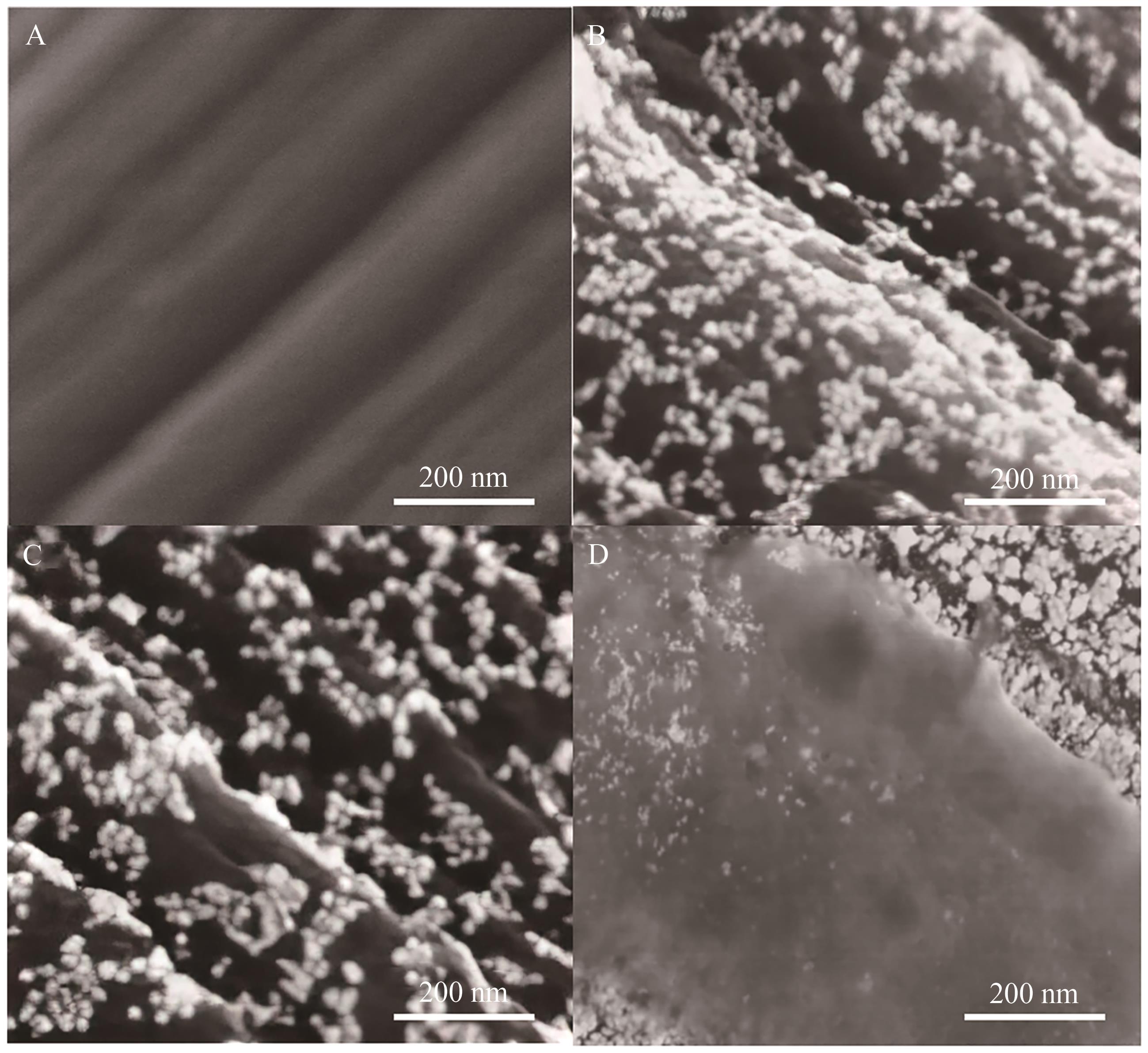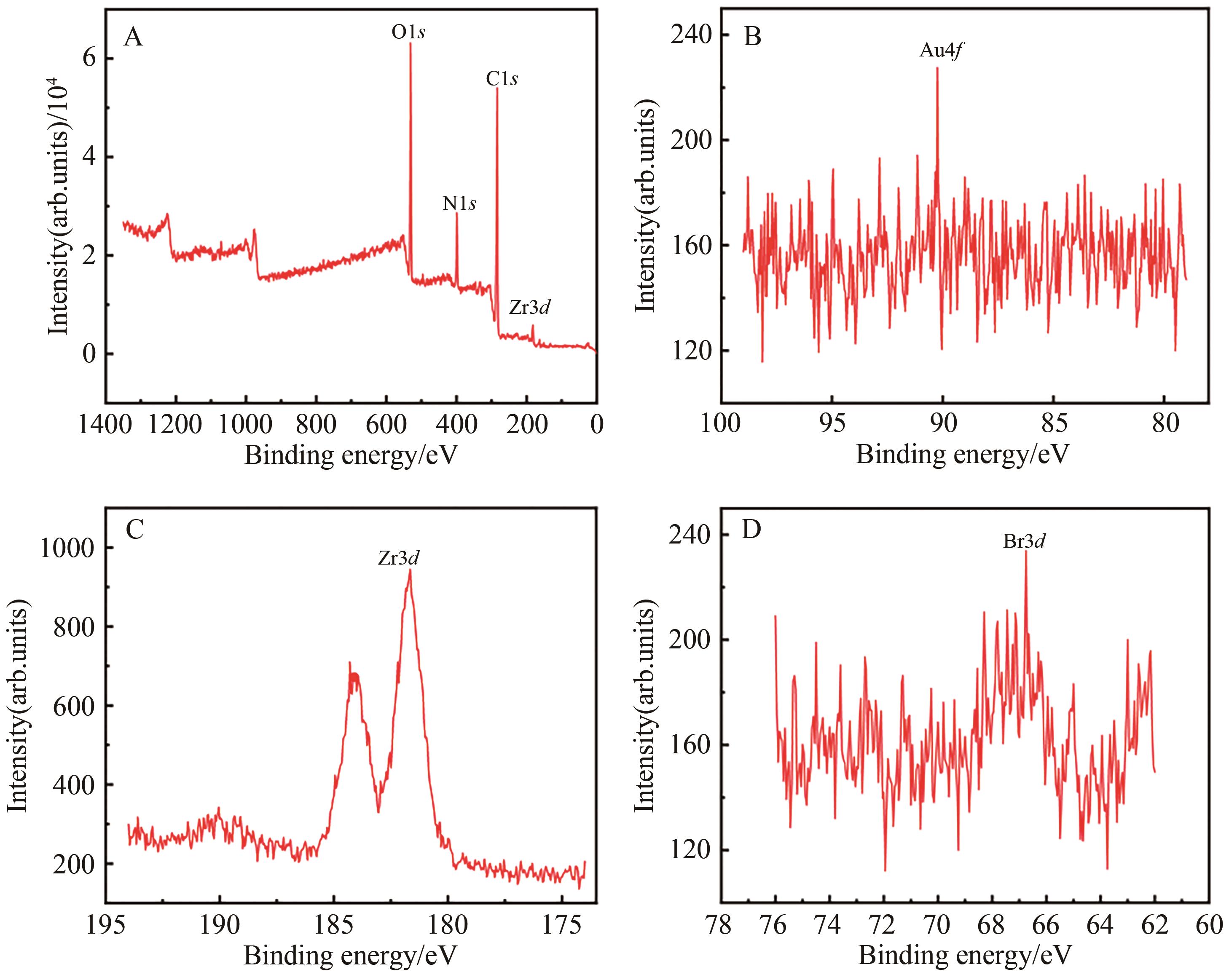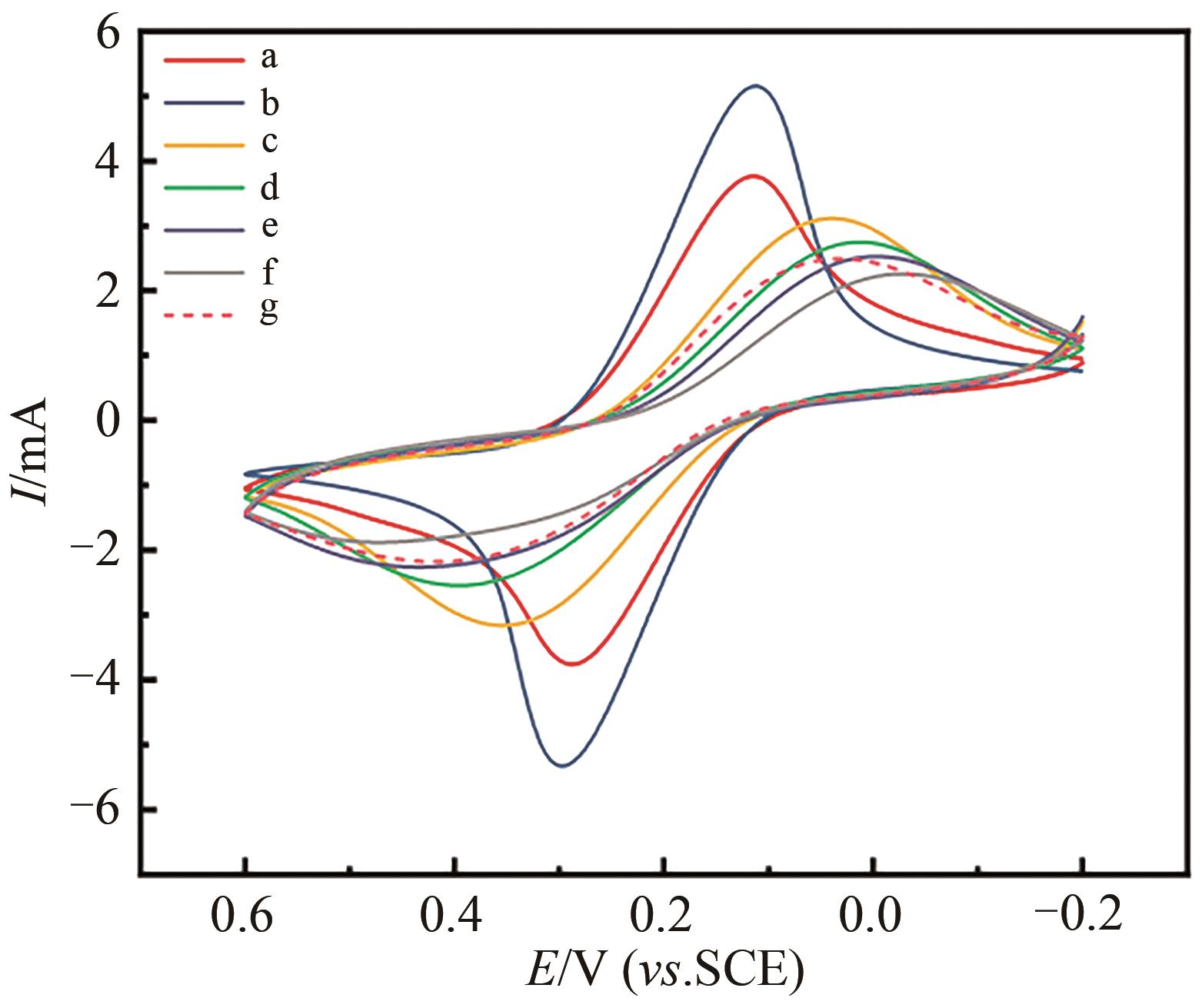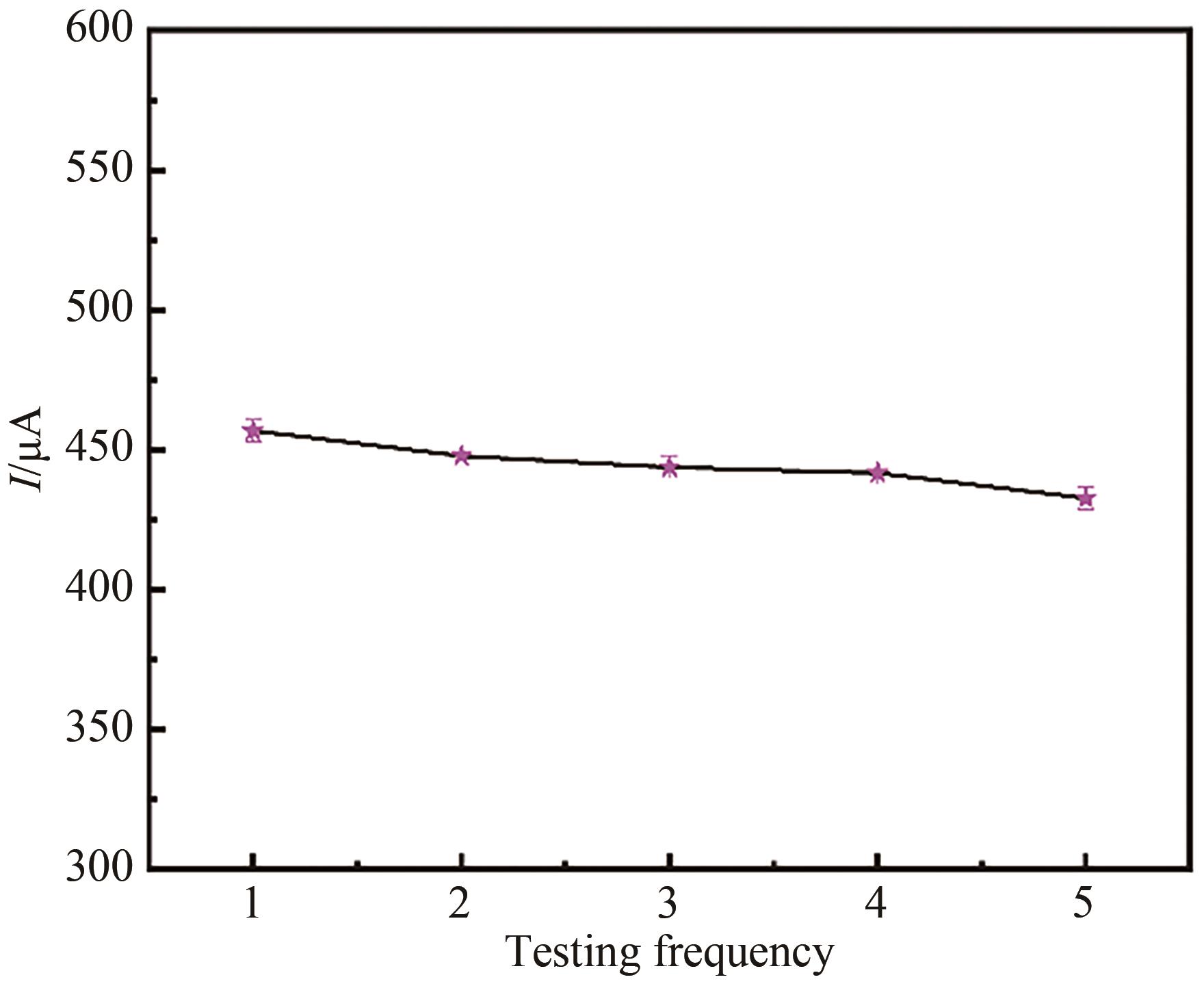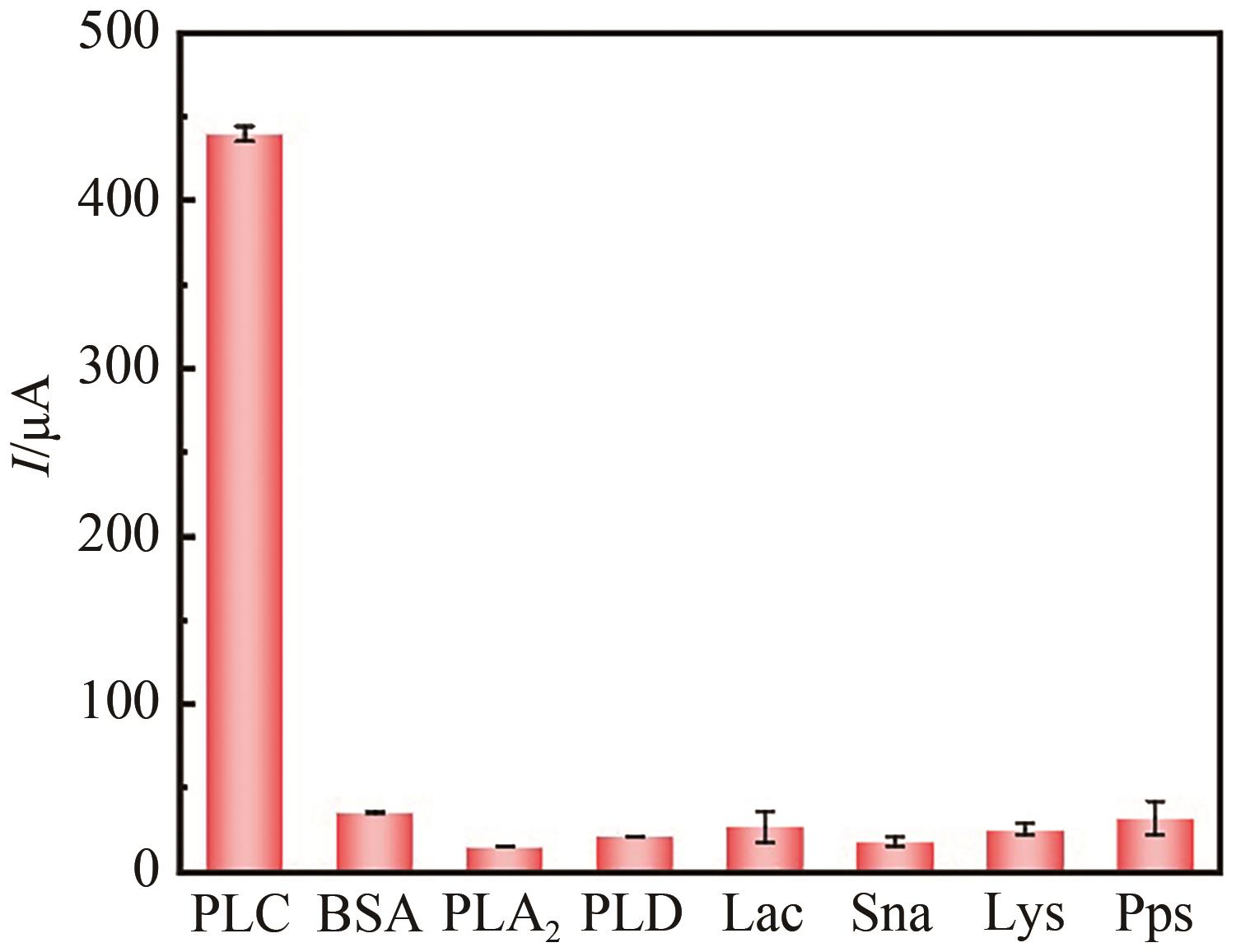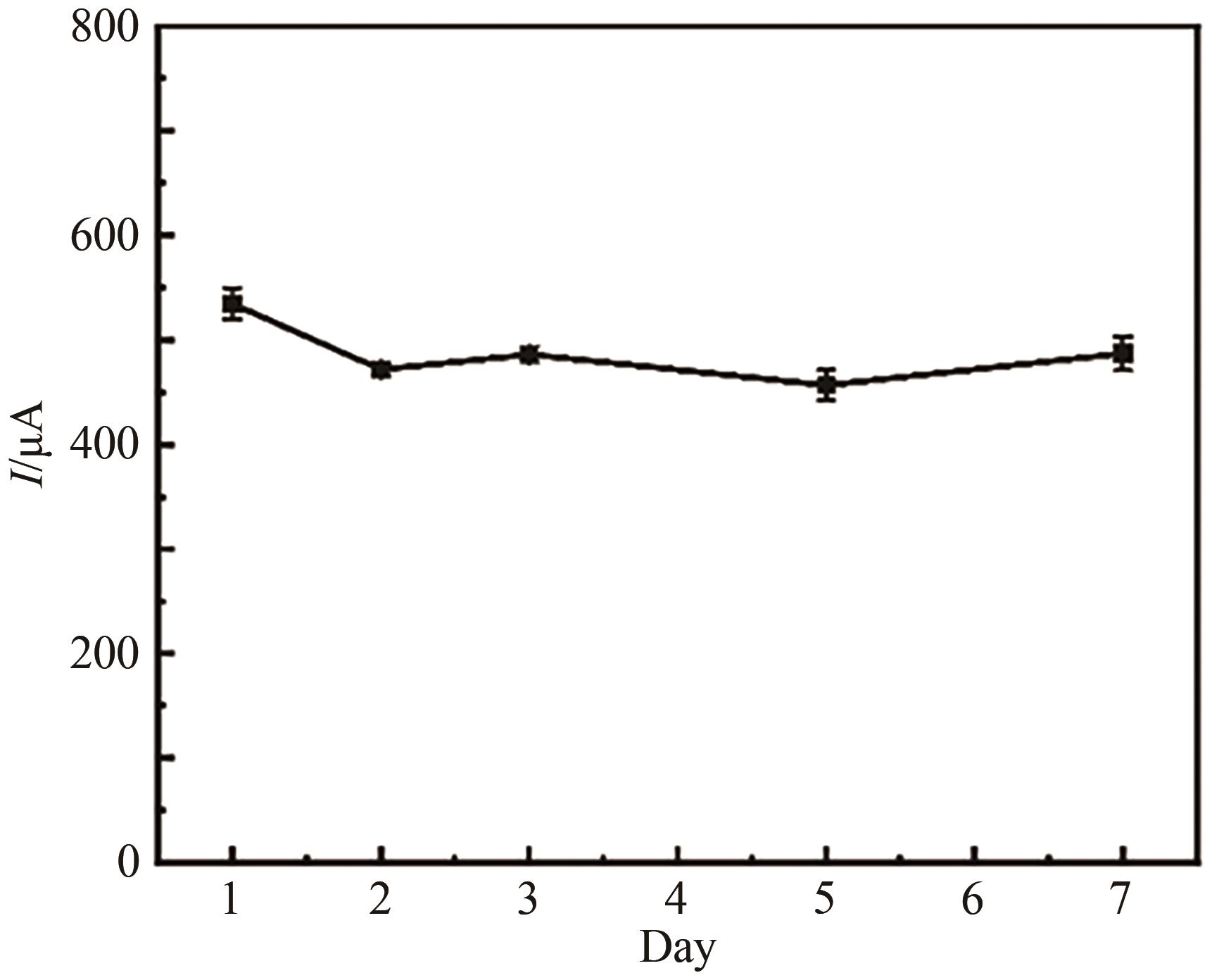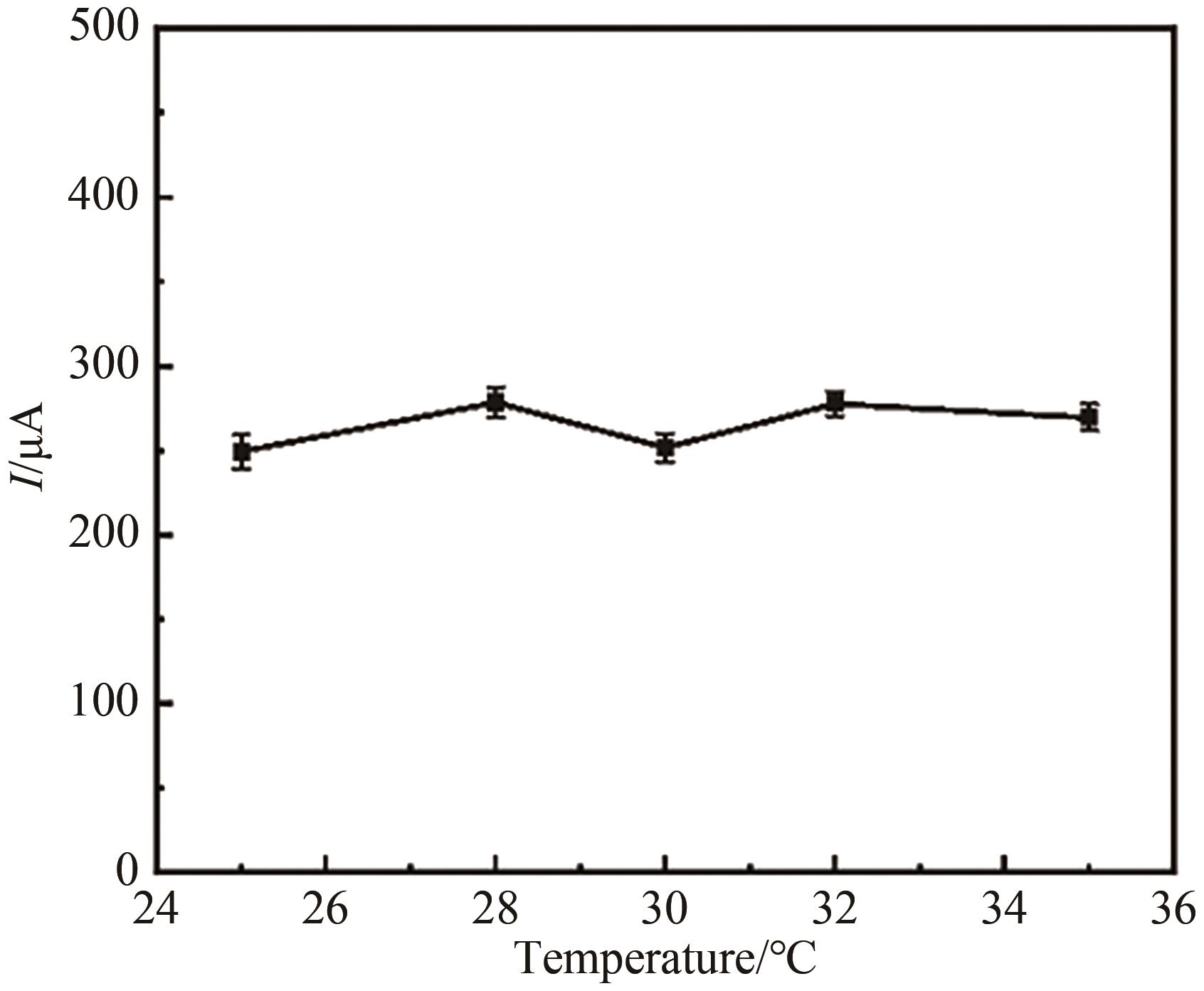
Chinese Journal of Applied Chemistry ›› 2024, Vol. 41 ›› Issue (7): 987-997.DOI: 10.19894/j.issn.1000-0518.240026
• Full Papers • Previous Articles Next Articles
Fabrication of an Electrochemical Sensor for Phospholipase C Detection Based on Flexible Electrodes and Signal Amplification Technology
Yao-Yao WANG, Ming-Yang SUN, Zuan YANG, Shao-Kai DU, Yu-Xuan HE, Yue SUN( )
)
- College of Chemistry and Chemical Engineering,Liaoning Normal University,Dalian 116029,China
-
Received:2024-01-23Accepted:2024-05-21Published:2024-07-01Online:2024-08-03 -
Contact:Yue SUN -
About author:yue0411@163.com
-
Supported by:the Natural Science Foundation of Liaoning Province(2021-MS-273);the Service Local Projects of Liaoning Education Department(JYTMS20231091);the National College Students Innovation and Entrepreneurship Training Program(202210165027);the Innovation and Entrepreneurship Training Program for College Students in Liaoning Province(S202310165008X)
CLC Number:
Cite this article
Yao-Yao WANG, Ming-Yang SUN, Zuan YANG, Shao-Kai DU, Yu-Xuan HE, Yue SUN. Fabrication of an Electrochemical Sensor for Phospholipase C Detection Based on Flexible Electrodes and Signal Amplification Technology[J]. Chinese Journal of Applied Chemistry, 2024, 41(7): 987-997.
share this article
Add to citation manager EndNote|Ris|BibTeX
URL: http://yyhx.ciac.jl.cn/EN/10.19894/j.issn.1000-0518.240026
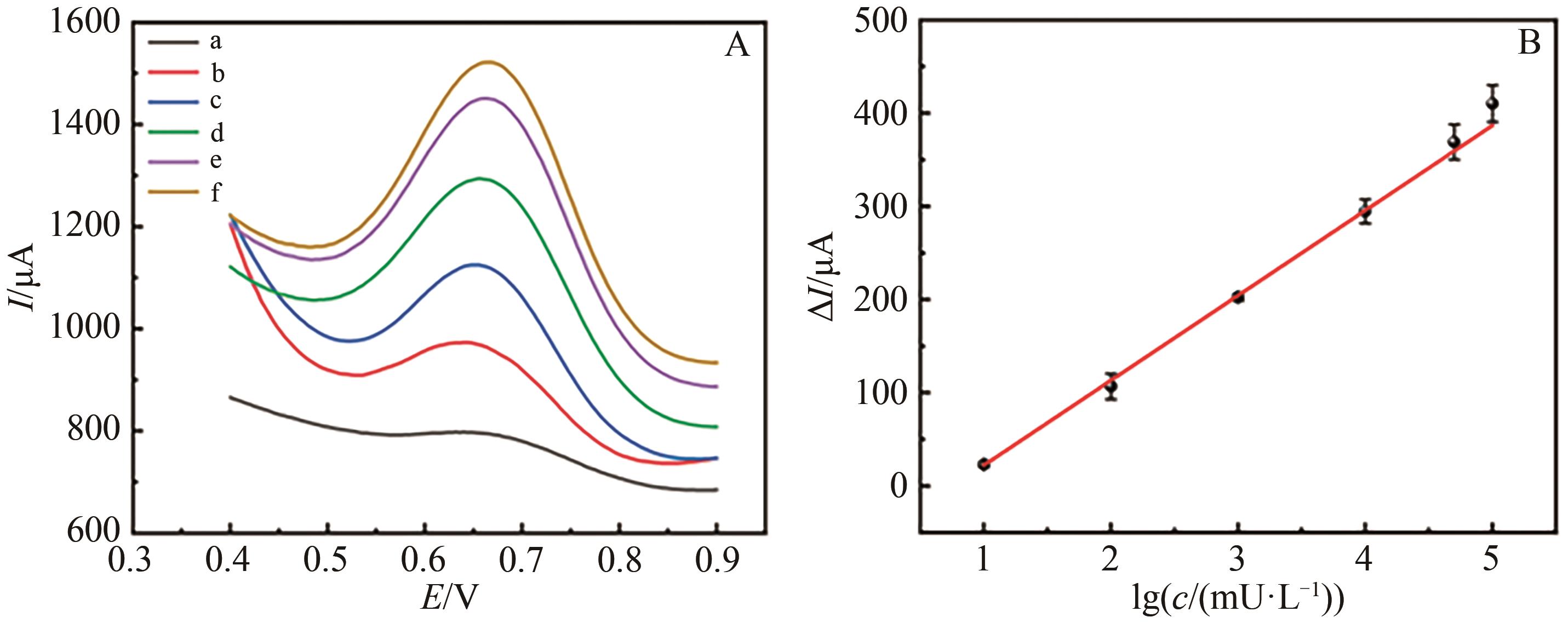
Fig.5 (A) SWV curves of sensor in 0.5 mol/L LiClO4 solution to detect PLC with different concentrations (the curves from a to f correspond to PLC concentrations of 10, 1×102, 1×103, 1×104, 1×104.69 and 1×105 mU/L); (B) Working curve of PLC detected by sensor
| Detection method | Main materials | Linear range/ (nmol·L-1) | Detection limit/ (nmol·L-1) | Ref. |
|---|---|---|---|---|
| Fluorescence method | 11-Mercaptocarboxylic acid-gold nanodot-liposome hybrids | 0.5~50 | 0.21 | [43] |
| Fluorescence method | Fluorescently labeled liposomes | 6.75~4.05×102 | 2.7 | [44] |
| Liquid mass spectrometry | 1-Palmitoyl-2-oleoyl-diacylglycerol | 0~27.5 | 0.4 | [45] |
| Fluorescence method | Water-soluble conjugated polyelectrolyte-lipid complexes | 0~1×105 | 1 | [46] |
| Electrochemical method | P(TEMPO)/PE/AuNPs/CC-modified electrodes | 1.35×10-2~1.35×102 | 4.817×10-3 | This work |
Table 1 Performance comparison with other analysis methods
| Detection method | Main materials | Linear range/ (nmol·L-1) | Detection limit/ (nmol·L-1) | Ref. |
|---|---|---|---|---|
| Fluorescence method | 11-Mercaptocarboxylic acid-gold nanodot-liposome hybrids | 0.5~50 | 0.21 | [43] |
| Fluorescence method | Fluorescently labeled liposomes | 6.75~4.05×102 | 2.7 | [44] |
| Liquid mass spectrometry | 1-Palmitoyl-2-oleoyl-diacylglycerol | 0~27.5 | 0.4 | [45] |
| Fluorescence method | Water-soluble conjugated polyelectrolyte-lipid complexes | 0~1×105 | 1 | [46] |
| Electrochemical method | P(TEMPO)/PE/AuNPs/CC-modified electrodes | 1.35×10-2~1.35×102 | 4.817×10-3 | This work |
| 1 | SURATEKAR R, PANDA A, RAGHU P, et al. Evidence of sinks and sources in the phospholipase C-activated PIP2 cycle[J]. FEBS Lett, 2018, 592(6): 962-972. |
| 2 | FUKAMI K, INANOBE S, KANEMARU K, et al. Phospholipase C is a key enzyme regulating intracellular calcium and modulating the phosphoinositide balance[J]. Prog Lipid Res, 2010, 49(4): 429-437. |
| 3 | KANEMARU K, NAKAMURA Y. Activation mechanisms and diverse functions of mammalian phospholipase C[J]. Biomolecules, 2023, 13(6): 915. |
| 4 | SINGH V, RAI R, MATHEW B J, et al. Phospholipase C: underrated players in microbial infections[J]. Front Cell Infect Microbiol, 2023, 13: 1089374. |
| 5 | EURTIVONG C, LEUNG E, SHARMA N, et al. Phosphatidylcholine-specific phospholipase C as a promising drug target[J]. Molecules, 2023, 28(15): 5637. |
| 6 | SALUCCI S, ARAMINI B, BARTOLETTI-STELLA A, et al. Phospholipase family enzymes in lung cancer: looking for novel therapeutic approaches[J]. Cancers, 2023, 15(12): 3245. |
| 7 | SEO E B, JANG H J, KWON S H, et al. Loss of phospholipase Cγ1 suppresses hepatocellular carcinogenesis through blockade of STAT3-mediated cancer development[J]. Hepatol Commun, 2022, 6(11) :3234-3246. |
| 8 | LI X, MENG P, SUN M, et al. An ultrasensitive electrochemical sensor for phospholipase C via signal amplification based on breathing ATRP and its application[J]. Analyst, 2023, 148(10): 2352-2361. |
| 9 | LI X, YANG Z, MENG P, et al. Ultrasensitive electrochemical detection of phospholipase C via dual signal amplification based on MVL ATRP and silver nanoparticles[J]. Microchem J, 2023, 191: 108847. |
| 10 | 李宇轩, 陈婷, 李鲁艳, 等. 碳布基树枝状PbO2在H2O2电化学传感器中的应用[J]. 山东建筑大学学报, 2023, 38(1): 95-101. |
| LI Y X, CHEN T, LI L Y, et al. Application of carbon cloth based dendritic PbO2 in H2O2 electrochemical sensor[J].J Shandong Jianzhu Univ, 2023, 38(1): 95-101. | |
| 11 | 马闯, 高娟娟, 张树鹏, 等. 基于不同工作电极的亚硝酸盐电化学传感器[J]. 大学化学, 2018, 33(6): 1-10. |
| MA C, GAO J J, ZHANG S P, et al. Electrochemical sensors for nitrite based on different working electrodes[J]. Univ Chem, 2018, 33(6): 1-10. | |
| 12 | TORRINHA Á, MORAIS S. Electrochemical (bio) sensors based on carbon cloth and carbon paper: an overview[J]. Trends Environ Anal, 2021, 142: 116324. |
| 13 | SARKAR P K, KAMILYA T, ACHARYA S. Introduction of triboelectric positive bioplastic for powering portable electronics and self-powered gait sensor[J]. ACS Appl Energ Mater, 2019, 2(8): 5507-5514. |
| 14 | DE PENNING R, MONZON N, PADALKAR S. Flexible zinc oxide-based biosensors for detection of multiple analytes[J]. Mater Res, 2022, 37: 2942-2950. |
| 15 | ZHOU Y, LV Y, DONG H, et al. Ultrasensitive assay of amyloid-beta oligomers using Au-vertical graphene/carbon cloth electrode based on poly(thymine)-templated copper nanoparticles as probes[J]. Sens Actuators B: Chem, 2021, 331:129429. |
| 16 | SHI J, LIN Y, QIN W, et al. Superior performance of a graphdiyne self-powered biosensor with exonuclease Ⅲ-assisted signal amplification for sensitive detection of microRNAs[J]. Analyst, 2022, 147(22): 4991-4999. |
| 17 | LIU Q, JIAN L, LIU R, et al. Metal-free photoinduced atom transfer radical polymerization for highly sensitive detection of lung cancer DNA[J]. Chem-Eur J, 2020, 26(7): 1633-1639. |
| 18 | APATA I E, TAWADE B V, CUMMINGS S P, et al. Comparative study of polymer-grafted BaTiO3 nanoparticles synthesized using normal ATRP as well as ATRP and ARGET-ATRP with sacrificial initiator with a focus on controlling the polymer graft density and molecular weight[J]. Molecules, 2023, 28(11): 4444. |
| 19 | LI S Y, SCHON B S, TRAVAS-SEJDIC J. Grafting of porous conductive fiber mats with an antifouling polymer brush by means of filtration-based surface initiated ATRP[J]. Macromol Rapid Commun, 2023: 2300069. |
| 20 | RONG L, SANTRA A, ROSS G, et al. Polymer grafted graphene via atom transfer radical polymerization (ATRP): a rheology improver in oil-based drilling fluids[J]. Mrs Commun, 2023, 13(3): 445-450. |
| 21 | LI R, AN Z. Achieving ultrahigh molecular weights with diverse architectures for unconjugated monomers through oxygen-tolerant photoenzymatic RAFT polymerization[J]. Angew Chem Int Ed, 2020, 59(49): 22258-22264. |
| 22 | ARONOVA M A, BYRNES C, LEE Y T, et al. Quantitative stem-eels imaging of ferritin distributions in cultured erythroblasts undergoing erythropoiesis[J]. Microsc Microanal, 2018, 24(S1): 2034-2035. |
| 23 | REEDER B J. The redox activity of hemoglobins: from physiologic functions to pathologic mechanisms[J]. Antioxid Redox Sign, 2010, 13(7): 1067-1123. |
| 24 | LIN S D, YOHANNES Y B, HWANG B J, et al. The effect of 2,2,6,6-tetramethylpiperidinyl-oxide (TEMPO) as an electrolyte additive and its SEI formation on Mcmb-Electrode[J]. ECS Trans, 2020, 97(7): 135. |
| 25 | 梁华哲. 聚酰胺胺负载TEMPO的制备及其催化氧化性能[D]. 石家庄: 河北科技大学, 2020. |
| LIANG H Z. Preparation of polyamide amine-supported TEMPO and its catalytic oxidation performance[D]. Shijiazhuang: Hebei University of Science and Technology, 2020. | |
| 26 | 饶春美, 高致远, 徐玉兵, 等. 双抗体夹心法测定血清YKL-40在肝硬化中的诊断价值研究[J]. 现代免疫学, 2017, 37(4): 313-316. |
| RAO C M, GAO Z Y, XU Y B, et al. Diagnostic value of double-antibody sandwich ELISA for serum YKL-40 in patients with liver cirrhosis.[J]. Curr Immunol, 2017, 37(4): 313-316. | |
| 27 | WANG S, MENG H, LI Y, et al. Polymer brushes grafted from graphene via bioinspired polydopamine chemistry and activators regenerated by electron transfer atom transfer radical polymerization[J]. J Polym Sci Pol Chem, 2019, 57(6): 689-698. |
| 28 | SU H L, YANG M M, ZHAO L M, et al. Recyclable magnetic Fe3O4 supported photocatalyst for the metal-free ATRP[J]. Eur Polym J, 2022, 177: 111476. |
| 29 | BESPALOV I, DATLER M, BUHR S, et al. Initial stages of oxide formation on the Zr surface at low oxygen pressure: an in situ FIM and XPS study[J]. Ultramicroscopy, 2015, 159: 147-151. |
| 30 | LI X, CHEN Z, CHEN Z, et al. An experimental and theoretical study on the photoluminescence of O and Br co-doped ZnS quantum dots synthesized by a solid-state reaction method[J]. J Alloy Compd, 2020, 845: 155405. |
| 31 | CHAPMAN P, DUCKER R E, HURLEY C R, et al. Fabrication of two-component, brush-on-brush topographical microstructures by combination of atom-transfer radical polymerization with polymer end-functionalization and photopatterning[J]. Langmuir, 2015, 31(21): 5935-5944. |
| 32 | SUN H, QIU Y, LU Y, et al. Ultrasensitive DNA electrochemical biosensor based on MnTBAP biomimetic catalyzed AGET ATRP signal amplification reaction[J]. Chem Commun, 2020, 56: 6636-6639. |
| 33 | AHMADPOUR S, TASHKHOURIAN J, HEMMATEENEJAD B. A chemometric investigation on the influence of the nature and concentration of supporting electrolyte on charging currents in electrochemistry[J]. J Electroanal Chem, 2020, 871: 114296. |
| 34 | GUO W, YIN Y X, XIN S, et al. Superior radical polymer cathode material with a two-electron process redox reaction promoted by graphene[J]. Energ Environ Sci, 2012, 5(1): 5221-5225. |
| 35 | WEI Y C, LI Y C, CHUNG M O, et al. Synthesis of fluorescent gold nanodot-liposome hybrids for detection of phospholipase C and its inhibitor[J]. Anal Chem, 2013, 85(18): 8834-8840. |
| 36 | TORLEY L, SILVERSTRIM C, PICKETT W. A turbidometric assay for phospholipase C andsphingomyelinase[J]. Anal Biochem, 1994, 222(2): 461-464. |
| 37 | MURAKAMI C, MIZUNO S, KADO S, et al. Development of a liquid chromatography-mass spectrometry based enzyme activity assay for phosphatidylcholine-specific phospholipase C[J]. Anal Biochem, 2017, 526: 43-49. |
| 38 | LIU Y, OGAWA K, SCHANZE K S. Conjugated polyelectrolyte based real-time fluorescence assay for phospholipase C[J]. Anal Chem, 2008, 80(1): 150-158. |
| [1] | Shi-Peng JIANG, Yu-Xi ZHOU, Pei-Ran MENG, Yan-Xuan XIE, Zhi-Yi SONG, Huan-Ying ZHAO, Yue SUN. Preparation and Properties of Ultramicro Imprinting Sensor for Human Serum Albumin via Metal-free Visible-light-induced Atom Transfer Radical Polymerization [J]. Chinese Journal of Applied Chemistry, 2023, 40(2): 299-308. |
| [2] | WANG Wei, LI Juan, BAI Ru, HAN Zhen, FENG Xuewei, SUN Yue. Preparation of Au/Polyacrylamide@Graphene Oxide/Nano-palladium Electrode via Metal-Free Visible-Light-Induced Atom Transfer Radical Polymerization and Its Detection of Ethanol [J]. Chinese Journal of Applied Chemistry, 2020, 37(5): 595-603. |
| [3] | LIU Yutong,ZHAO Mengyuan,LI Siyu,YANG Yifei,SUN Yue. Preparation of Molecularly Imprinted Polymers by Superoxide Dismutase-Catalyzed Electrochemically-Mediated Atom Transfer Radical Polymerization [J]. Chinese Journal of Applied Chemistry, 2019, 36(5): 585-594. |
| [4] | YANG Muquan, XIAO Lingyu, ZHANG Xuan, YAN Yue. Fabrication of Poly(4-Vinylpyridine-b-Polyethylene Glycol) Diblock Copolymer Brushes from Au Surfaces and Their pH Responsive Behavior [J]. Chinese Journal of Applied Chemistry, 2019, 36(4): 431-439. |
| [5] | Ruoxin YUAN, Xingang LIU, Chuhong ZHANG. Preparation of Tin Oxide-Graphene Flexible Electrode and Its Application in Lithium Ion Battery [J]. Chinese Journal of Applied Chemistry, 2018, 35(7): 825-833. |
| [6] | LIU Yaliu, YUAN Zhongzhi, LIU Liling. Preparation and Electrochemical Characteristics of Manganese Dioxide/graphene Composite Paper Electrode [J]. Chinese Journal of Applied Chemistry, 2015, 32(7): 843-848. |
| [7] | HUANG Xuehong, LIN Juan, ZHENG Ronxue, LIN Yifeng, DING Fuchuan*, LING Qidan*. Synthesis of Side-chain-sulfonated Poly(ether ether ketone) as Cation Exchange Membranes by Atom Transfer Radical Polymerization [J]. Chinese Journal of Applied Chemistry, 2014, 31(08): 878-884. |
| [8] | CHEN Min, DENG Zhijun*, ZHANG Liben, LI Xiaogang . Metal-mediated Activators Generated by Electron Transfer for Atom Transfer Radical Polymerization of Methyl Methacrylate with Basic Ionic Liquids as the Catalyst [J]. Chinese Journal of Applied Chemistry, 2014, 31(05): 553-559. |
| [9] | DING Wei*, WANG Ling, YU Tao, QU Guangmiao, GAO Xiang, LI Ming. Atom Transfer Radical Copolymerization of Acrylamide Under Microwave Irradiation [J]. Chinese Journal of Applied Chemistry, 2013, 30(04): 398-402. |
| [10] | ZHONG Yu, SHEN Jun, WEI Rongqing, LIU Xiaoning*. Removal of Cu-ion in block copolymer of PMMA-PLLA-PMMA prepared via ATRP by washing-extraction method [J]. Chinese Journal of Applied Chemistry, 2011, 28(03): 254-257. |
| [11] | TANG Long-Xiang, FAN Bao-Lin, QU Long, LIU Chun-Hua*, WANG Ping-Hua. Synthesis & Application of Immobilized Ligand of Atom Transfer Radical Polymerization [J]. Chinese Journal of Applied Chemistry, 2010, 27(08): 882-886. |
| [12] | DING Wei*, LV Chong-Fu, SUN Ying, YU Tao, QU Guang-Miao. Atom Transfer Radical Polymerization of Acrylamide in Ionic Liquid [J]. Chinese Journal of Applied Chemistry, 2010, 27(06): 642-645. |
| [13] | YE De, LI Na-Jun, LU Jian-Mei*, XU Qiang-Feng, WANG Li-Hua, JIA Xue-Wei, YAN Fe. Two monomers containing 1,8-naphthalimide segments and The photophysical properties of the monomers and their homopolymers [J]. Chinese Journal of Applied Chemistry, 2009, 26(08): 929-934. |
| [14] | . Studies on grafting PBA onto surface of nano- silicon dioxide via ATRP reaction & modification of POM [J]. Chinese Journal of Applied Chemistry, 2009, 26(07): 775-779. |
| Viewed | ||||||
|
Full text |
|
|||||
|
Abstract |
|
|||||
